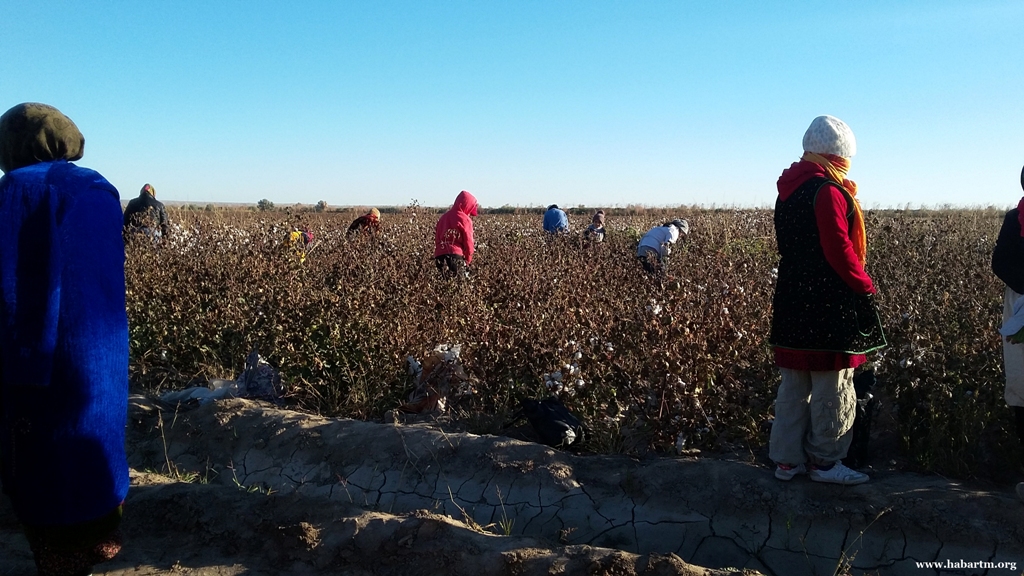A new report has asserted there is no way to prevent the practice of forced labour and child labour in Turkmenistan’s cotton harvest.
The report from Turkmen News and the Turkmen Initiative for Human Rights, which are both members of the Cotton Campaign, reveals forced labour and child labour as part of Turkmenistan’s cotton harvest campaign, did take place last year.
The report covers four of Turkmenistan’s five regions — Balkan, Dashoguz, Lebap, and Mary. The findings show that forced labour of public sector employees in the 2021 harvest was widespread and systematic. Independent monitors also recorded cases of child labour, with children working in the fields along with their parents or as replacement workers for parents forced to pick cotton or pay a replacement picker.
Some service members and vulnerable groups, including migrant workers, people with registered addictions, or who were accused of prostitution or alimony delinquency, were also forced to pick cotton. At the beginning of the cotton harvest, workers in state organisations and enterprises, including schools, hospitals, and factories, were divided into groups. In September, every employee had either to go to the cotton fields or to pay cash to hire pickers three times a week. Depending on the region and enterprise, people paid 20-30 manats (approximately US$1-$1.50) to hire a picker per day. On the only rest day, Sunday, staff meetings were held to inform the employees that large numbers would be going to pick cotton.
Child labour was driven by poverty and by the forced labour system, with some children in their teens picking cotton to earn money for their families and others working as replacement workers for their parents or sent to the fields by their schools
The Turkmen government maintains total control of cotton production and forces farmers to meet official production quotas under threat of penalty including loss of their land.
In 2021, extreme drought conditions in combination with poor management and distribution of seeds, fertilisers, and equipment by the government, resulted into low yields. Independent monitors recorded cases of farmers being fined or having their land confiscated, as a result of not being able to meet the cotton quotas imposed by the state.
Through complex and opaque global supply chains, products made with Turkmen cotton enter the European market, with companies, governments, and consumers, often unknowingly, benefiting from the forced labour system in Turkmen cotton production.
The report sheds light on the trade flows that allow forced labour Turkmen cotton to enter global supply chains through two main streams:
i) As finished goods produced in Turkmenistan and exported through direct trade routes or transshipped to, for example, Kazakhstan, Russia, Belarus, Italy, the US, and Canada
ii) Through suppliers in countries that produce textiles using Turkmen cotton, yarn and fabric, in particular Turkey, but also China, Pakistan, and Portugal, among others.
The Cotton Campaign called on governments to adopt and robustly enforce effective border control mechanisms to ban imports of forced labour products. Although the US has had an import ban on all cotton products from Turkmenistan in place since 2018, information on enforcement is insufficient and cotton products from Turkmenistan continue to be sold to US consumers.
The EU has committed to adopting new measures to combat forced labour. The Cotton Campaign has called on the EU to include a border mechanism to prevent goods tainted with forced labour from entering the world’s largest common market. Turkmen cotton reaches European consumers as finished goods produced outside the EU and exported to the EU — in particular goods made in Turkey, with Turkey being the largest manufacturer of cotton products using yarn and fabric originating in Turkmenistan and the third-largest supplier of textiles to the EU — or through direct trade routes, with Turkmenistan exporting cotton, yarn, and fabric to countries like Portugal, for production of finished goods.
To ensure forced labour-free global cotton supply chains, the Cotton Campaign says import control mechanisms should be complemented by human rights due diligence obligations on companies to map their supply chains and exclude forced labour cotton. And to effectively address the state-imposed forced labour system in the harvest of Turkmen cotton, these control mechanisms should allow for a regional scope that ensures all goods, made wholly or partially with Turkmen cotton are banned.
Raluca Dumitrescu, coordinator of the Cotton Campaign, says: “In Turkmenistan, just as in the Xinjiang Uygur Autonomous Region (XUAR), companies cannot prevent or remediate forced labour. For this reason, brands and retailers must establish a legally-binding policy that prohibits the use of cotton from Turkmenistan and prohibits business with companies that use it, and require all spinning and fabric mills in their supply chains to implement the same policy”.
Commenting on the report, Allison Gill, the forced labour programme director at Global Labor Justice-International Labor Rights Forum (GLJ-ILRF), which hosts the Cotton Campaign, says: “Research reveals that Turkmen cotton enters the global markets, including the EU and US brands and governments must implement robust mechanisms to eliminate forced labour from supply chains and end their complicity in the forced labour system in Turkmenistan.”
Click here for the full report.


